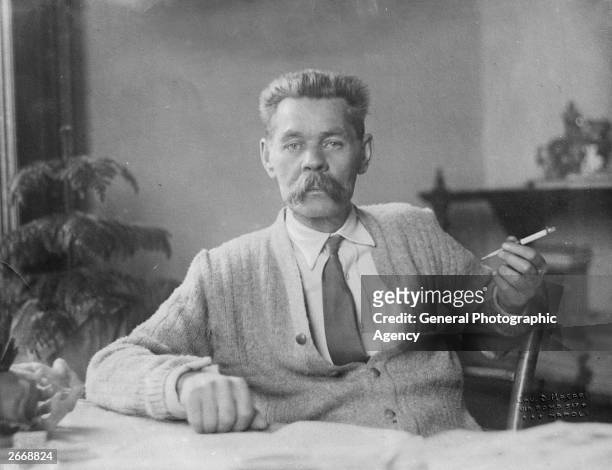
Maxim Gorky referred to as a figurehead of socialist realism is noted for painting members of the fair sex with brighter hues. Right, it is hardly possible to get his works in which the word ‘mother’ is not mentioned. This bent of his is attributed to his grandmother. Telling him tales of edifying nature in his formative years, she brought him up showering him with all necessary love when a kid he sought a comforting chest ill-treated by his stepfather often beating him and his mother. His hatred towards his stepfather and his attempt to defend his mother from the male chauvinist man are well reflected in his book “My Childhood”. Gorky lost his biological father and soon his mother early in life.
True to the saying there are individual differences in penning down literary pieces, there is a heated debate whether content or form matters. Many give more focus on the form, while others on the content. In other words, some are more concerned on the entertaining nature of the literary work. Foregrounding the language like formalists to create aesthetic effect, fun or surprise occupies their mind. They see a literary piece as a reflection of the tidbits of life. They may not dig deep to reveal social injustices or address social issues.
On the other end of the scale, though every literary work written in whatever form has a message, some are more concerned about the social messages the works carry across. How are women painted in the work? How children are treated and how economic injustices are addressed and the like take center stage in their works.
The styles above could be broadly categorized as “Art for Art’s sake” or “Art for life’s sake.”
When we come to Maxim Gorky, we notice that he was a votary of Art for life’s sake. Peculiarly, he was conveying the burning social messages of his time interestingly. Tilting more to Art for life’s sake he was hitting a balance between the two styles on diametrically opposite ends.
Observably most fans go for works done in art for art sake claiming that it is relatively palatable. They downplay art for life’s sake a propagandist one. Fans for art for life’s sake slam art for art’s sake claiming that if a literary piece is devoid of a beef, it goes astray solely focusing on superficial things.
Back to Gorky, placing more focus on the social messages he hits a balance between art for life’s sake and art for art’s sake. With word pictures, the way he describes the setting in his work is unmatched as he vividly portrayed Italy, where he stayed as a refugee.
Also, in describing characters Gorky never stops short of features indicating that he knows a broad array of people, especially from the lower class as witnessed in his novel ‘My Universities’. In hi workshe fantastically shows the beauty of the life of ordinary people,
Among the short stories Gorky wrote in Italy are found ‘Let us praise Mother’ and ‘The Mother of the traitor’.
Let us see how he described women in two short stories compiled in his book ‘Tales of Italy.’
The craft he used to write “Let us praise mother” is creating contrasts between the respectfulness and glory of a mother on one hand and how furious a ruthless king that has been shedding blood vengefully could be. Using symbolism here and there he creates the required opposite images.
At the climax the brutal king, who in cold blood was shedding blood, bows down before the reverential mother whom even wild animals treat respectfully. Gorky also used the satiric and wisdom-packed utterances of a poet in the story that accompanies the king to mellow his irritability and wield influence on his decisions. Gorky also put words in the mouth of the poet, whom the ruthless king doted on, to laud mothers.
The conflict in the story between the anxiety and fear provoked by a merciless king and the respectfulness and honor of a poor mother whose child is held captive by the irritable king and the possible confrontation between the two create suspense to propel the story forward.
The coming to amity between the protagonist the poor mother and the antagonist the brutal king after a peaceful dialogue creates the resolution, for the king returns the kid to her mother with a bow.
Gorky employed the same technique in crafting the short story “Mother of the traitor.” After drawing the attention of readers on the strong bond between a mother and her son in one hand and the loathsomeness of treason, once more, bringing into play images and symbols and contrasting the elements in the two sets, he creates a conflict that finds a resolution via a defamiliarized plot. The mother punishes her treasonous son, who conniving with an enemy was about to demolish his motherland. In this story Gorky shows the mercilessness of a merciful mother when a question mark hangs over the furtherance of a motherland. The suspense and the unexpected ending allow this story to stick out.
And also, another short story entitled “The Judgment” about an informal justice system by the proletariat shows how wise women, as judges, could handle defamation of an affair to spare a family from crumbling down. The way the women judges outwits the offender adds spice to the story to make it savory.
Gorky believes women must be held in the highest esteem as they create tomorrow with their children, whom he sees a harbinger to days ahead.
BY ALEM HAILU G/KRISTOS
THE ETHIOPIAN HERALD FRIDAY 8 MARCH 2024





